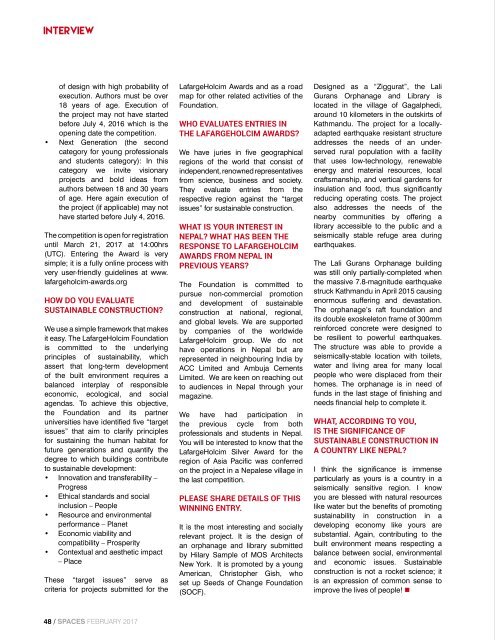SPACES feb issue 2017
Create successful ePaper yourself
Turn your PDF publications into a flip-book with our unique Google optimized e-Paper software.
Interview<br />
of design with high probability of<br />
execution. Authors must be over<br />
18 years of age. Execution of<br />
the project may not have started<br />
before July 4, 2016 which is the<br />
opening date the competition.<br />
• Next Generation (the second<br />
category for young professionals<br />
and students category): In this<br />
category we invite visionary<br />
projects and bold ideas from<br />
authors between 18 and 30 years<br />
of age. Here again execution of<br />
the project (if applicable) may not<br />
have started before July 4, 2016.<br />
The competition is open for registration<br />
until March 21, <strong>2017</strong> at 14:00hrs<br />
(UTC). Entering the Award is very<br />
simple; it is a fully online process with<br />
very user-friendly guidelines at www.<br />
lafargeholcim-awards.org<br />
How do you evaluate<br />
Sustainable Construction?<br />
We use a simple framework that makes<br />
it easy. The LafargeHolcim Foundation<br />
is committed to the underlying<br />
principles of sustainability, which<br />
assert that long-term development<br />
of the built environment requires a<br />
balanced interplay of responsible<br />
economic, ecological, and social<br />
agendas. To achieve this objective,<br />
the Foundation and its partner<br />
universities have identified five “target<br />
<strong>issue</strong>s” that aim to clarify principles<br />
for sustaining the human habitat for<br />
future generations and quantify the<br />
degree to which buildings contribute<br />
to sustainable development:<br />
• Innovation and transferability –<br />
Progress<br />
• Ethical standards and social<br />
inclusion – People<br />
• Resource and environmental<br />
performance – Planet<br />
• Economic viability and<br />
compatibility – Prosperity<br />
• Contextual and aesthetic impact<br />
– Place<br />
These “target <strong>issue</strong>s” serve as<br />
criteria for projects submitted for the<br />
LafargeHolcim Awards and as a road<br />
map for other related activities of the<br />
Foundation.<br />
Who evaluates entries in<br />
the LafargeHolcim Awards?<br />
We have juries in five geographical<br />
regions of the world that consist of<br />
independent, renowned representatives<br />
from science, business and society.<br />
They evaluate entries from the<br />
respective region against the “target<br />
<strong>issue</strong>s” for sustainable construction.<br />
What is your interest in<br />
Nepal? What has been the<br />
response to LafargeHolcim<br />
Awards from Nepal in<br />
previous years?<br />
The Foundation is committed to<br />
pursue non-commercial promotion<br />
and development of sustainable<br />
construction at national, regional,<br />
and global levels. We are supported<br />
by companies of the worldwide<br />
LafargeHolcim group. We do not<br />
have operations in Nepal but are<br />
represented in neighbouring India by<br />
ACC Limited and Ambuja Cements<br />
Limited. We are keen on reaching out<br />
to audiences in Nepal through your<br />
magazine.<br />
We have had participation in<br />
the previous cycle from both<br />
professionals and students in Nepal.<br />
You will be interested to know that the<br />
LafargeHolcim Silver Award for the<br />
region of Asia Pacific was conferred<br />
on the project in a Nepalese village in<br />
the last competition.<br />
Please share details of this<br />
winning entry.<br />
It is the most interesting and socially<br />
relevant project. It is the design of<br />
an orphanage and library submitted<br />
by Hilary Sample of MOS Architects<br />
New York. It is promoted by a young<br />
American, Christopher Gish, who<br />
set up Seeds of Change Foundation<br />
(SOCF).<br />
Designed as a “Ziggurat”, the Lali<br />
Gurans Orphanage and Library is<br />
located in the village of Gagalphedi,<br />
around 10 kilometers in the outskirts of<br />
Kathmandu. The project for a locallyadapted<br />
earthquake resistant structure<br />
addresses the needs of an underserved<br />
rural population with a facility<br />
that uses low-technology, renewable<br />
energy and material resources, local<br />
craftsmanship, and vertical gardens for<br />
insulation and food, thus significantly<br />
reducing operating costs. The project<br />
also addresses the needs of the<br />
nearby communities by offering a<br />
library accessible to the public and a<br />
seismically stable refuge area during<br />
earthquakes.<br />
The Lali Gurans Orphanage building<br />
was still only partially-completed when<br />
the massive 7.8-magnitude earthquake<br />
struck Kathmandu in April 2015 causing<br />
enormous suffering and devastation.<br />
The orphanage’s raft foundation and<br />
its double exoskeleton frame of 300mm<br />
reinforced concrete were designed to<br />
be resilient to powerful earthquakes.<br />
The structure was able to provide a<br />
seismically-stable location with toilets,<br />
water and living area for many local<br />
people who were displaced from their<br />
homes. The orphanage is in need of<br />
funds in the last stage of finishing and<br />
needs financial help to complete it.<br />
What, according to you,<br />
is the significance of<br />
sustainable construction in<br />
a country like Nepal?<br />
I think the significance is immense<br />
particularly as yours is a country in a<br />
seismically sensitive region. I know<br />
you are blessed with natural resources<br />
like water but the benefits of promoting<br />
sustainability in construction in a<br />
developing economy like yours are<br />
substantial. Again, contributing to the<br />
built environment means respecting a<br />
balance between social, environmental<br />
and economic <strong>issue</strong>s. Sustainable<br />
construction is not a rocket science; it<br />
is an expression of common sense to<br />
improve the lives of people! •<br />
48 / <strong>SPACES</strong> February <strong>2017</strong>


















